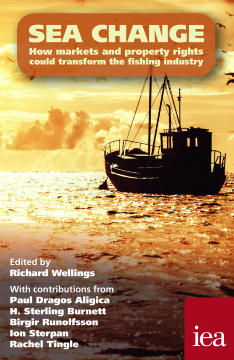
BOOK
Sea Change: How Markets and Property Rights Could Transform the Fishing Industry
Richard Wellings | Philip Booth | Paul Dragos Aligica | H. Sterling Burnett | Birgir Runolfsson | Ion Sterpan | Rachel Tingle
(2017)
Additional Information
Book Details
Abstract
Government management of fisheries has been little short of disastrous. In many regions, valuable fish stocks have collapsed as a result of overfishing. Ill-conceived regulation also means that every year millions of tons of edible fish are thrown back dead into the sea. While an absence of established property rights means that wild fish are vulnerable to overfishing, the problem is greatly exacerbated by large subsidies. State intervention has created significant overcapacity in the industry and undermined the economic feedback mechanisms that help to protect stocks. This short book sets out a range of policy options to improve outcomes. As well as ending counterproductive subsidies, these include community-based management of coastal zones and the introduction of individual transferable quotas. The analysis is particularly relevant to the UK as it begins the process of withdrawal from the European Union. After decades of mismanagement under the Common Fisheries Policy, Brexit represents a major opportunity to adopt an economically rational approach that benefits the fishing industry, taxpayers and consumers.
Table of Contents
| Section Title | Page | Action | Price |
|---|---|---|---|
| _GoBack | xi | ||
| The authors | ix | ||
| Foreword | xii | ||
| Summary | xvi | ||
| Tables and figures | xix | ||
| 1\tIntroduction | 1 | ||
| Richard Wellings | 1 | ||
| Global fish stocks | 2 | ||
| The tragedy of the commons | 6 | ||
| How market mechanisms protect fisheries | 9 | ||
| Cutting off the invisible hand | 12 | ||
| Fishing for favours | 14 | ||
| The tragedy of state regulation | 15 | ||
| Property rights approaches | 18 | ||
| Conclusions | 21 | ||
| References | 23 | ||
| 2\tSubsidising decline: government intervention in the fishing industry | 26 | ||
| H. Sterling Burnett | 26 | ||
| Why have the fisheries declined? | 28 | ||
| Government policies encourage unsustainable harvests | 29 | ||
| Subsidies: what kind and how much? | 31 | ||
| Misguided government responses to the fisheries decline | 34 | ||
| Current policies harm commercial fishing operators | 38 | ||
| Acting to reverse fisheries decline | 39 | ||
| End subsidies and tax breaks | 42 | ||
| Replace the current regulatory system with a system of property rights | 43 | ||
| Encourage other countries to cut subsidies and adopt similar property-based fisheries policies | 45 | ||
| References | 49 | ||
| 3\tThe European Common Fisheries Policy | 52 | ||
| Rachel Tingle | 52 | ||
| 1957–69: The conception and early development of the CFP | 55 | ||
| 1970–82: The establishment of common Community waters | 57 | ||
| 1983–92: The development of a fisheries management system | 64 | ||
| 1993–2002: The introduction of vessel licensing and effort controls | 70 | ||
| 2003–13: Reform of the CFP | 72 | ||
| 2014 Onwards: last chance for the CFP? | 79 | ||
| Appendix: UK system for apportioning national fishing quotas | 88 | ||
| References | 91 | ||
| 4\tGoverning the fisheries: insights from Elinor Ostrom’s work | 95 | ||
| Paul Dragos Aligica and Ion Sterpan | 95 | ||
| Introduction | 95 | ||
| Public choice and voluntary action | 97 | ||
| The approach | 98 | ||
| Governance regimes | 100 | ||
| Performance criteria | 102 | ||
| Co-management and the commons | 104 | ||
| Government interference and failure | 105 | ||
| A case of fragile institutions: the Nova Scotian inshore fisheries | 107 | ||
| A case of robust institutions: the Maine lobster industry | 110 | ||
| Conclusions | 113 | ||
| References | 114 | ||
| 5\tRights-based ocean fishing in Iceland | 117 | ||
| Birgir Runolfsson | 117 | ||
| The fisheries problem | 118 | ||
| Creating rights to fishing | 120 | ||
| Criticism and concerns about an ITQ system | 123 | ||
| ITQs in practice | 128 | ||
| Conclusion | 139 | ||
| References | 140 | ||
| About the IEA | 144 | ||
| Table 1\tLandings of fish into the UK by UK and foreign vessels, 1938–2014 (thousand tonnes) | 83 | ||
| Figure 1\tGlobal fish catch, 1950–2013 (wild capture) | 4 | ||
| Figure 2\tGlobal fish production from aquaculture, 1950–2013 | 5 | ||
| Figure 3\tExclusive Economic Zones around the British Isles | 63 | ||
| Figure 4\tProfits in the Icelandic fisheries industry, 1980–2012 | 138 |
